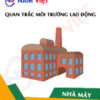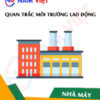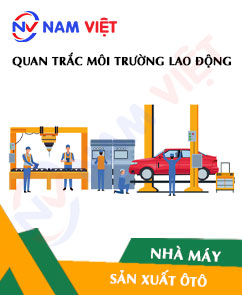Occupational environment monitoring at the factory producing electric fans
99,000 ₫
Note: The above price is calculated for one sample, the price may fluctuate depending on the area of the environment to be monitored and the movement of the market. For more accurate price support, please refer to the quotation table or contact directly with our consulting staff.
Environmental monitoring of electric fan manufacturing factories is a session of collecting, analyzing, and evaluating factors in the workplace that may be harmful to the health of workers.
Table of Contents
Toggle1. Overview of Electric Fan Manufacturing Factories
a. What is an electric fan manufacturing factory?
A manufacturing factory for electric fans is a facility that mass-produces various types of electric fans to meet cooling and ventilation needs in different environments. These factories typically produce industrial and household electric fans of different sizes and capacities for various applications.
During production, machinery and equipment such as metal cutting machines, plastic injection machines, welding machines, and quality testing machines are commonly used to support the production process and ensure product quality.

b. Production stages in electric fan manufacturing factories
Production stages in electric fan manufacturing factories may include:
- Design and research: The factory will have a design and research department to develop new models and features for electric fans.
- Component processing: Parts of the electric fan, such as blades, motors, casing, protective grills, and controls, are processed and manufactured separately.
- Assembly: Processed parts are assembled into a complete product. This includes attaching the fan blades to the motor shaft, installing the casing and protective grill, and connecting electronic components and controls.
- Quality testing: After assembly, the electric fan undergoes a quality control process to ensure proper operation and safety. Testing may include functional checks, performance measurements, and electrical safety inspections.
- Packing and warehousing: After quality testing, the fans are packaged in boxes and prepared for shipment to retailers or end customers.

c. Types of machinery used in electric fan manufacturing factories
In electric fan manufacturing factories, several types of machinery are commonly used for production and processing. Some common machinery includes:
- Metal cutting machines: Used to cut and process metal parts such as fan blades, casings, protective grills, and other components.
- Plastic injection machines: Used to mold and process plastic parts such as fan casings, caps, and other plastic components.
- Welding machines: Used to weld metal components together to form parts of the electric fan.
- Die casting machines: Used to cast metal components such as fan casings and other parts from materials like aluminum, cast iron, or steel.
- CNC machining centers: Precision machines used to process metal parts according to specific sizes and shapes, ensuring accuracy and quality of fan components.
- Frame assembly machines: Used to assemble fan frames and combine components into a complete product.
- Quality inspection machines: Used to verify technical specifications and quality of the fan after production, including functional tests, performance measurements, and electrical safety checks.
- Printing machines: Used to print or apply labels, images, or product information onto fan surfaces.
- Packing machines: Used to package electric fans into boxes or other containers, including sealing and labeling.

d. Occupational diseases that workers in electric fan manufacturing factories may face
Workers in electric fan manufacturing factories may be exposed to certain occupational diseases due to hazardous environmental factors and the nature of their work. Common occupational diseases include:
- Respiratory diseases: Exposure to metal dust, chemical fumes, or paint vapors during production can cause respiratory issues such as bronchitis, asthma, pneumonia, or lung damage.
- Hearing disorders: Continuous high noise levels from production processes can damage hearing, causing hearing loss, tinnitus, or ear infections.
- Skin diseases: Contact with materials and chemicals during production can lead to skin irritation, dermatitis, rashes, or other skin-related problems.
- Injuries: Work in the factory may pose risks of cuts, burns, impact injuries, or dislocations from using machinery, tools, and heavy materials.
- Musculoskeletal disorders: Repetitive movements, lifting heavy objects, or working in awkward positions may lead to spine degeneration, joint wear, or back pain.
- Infections: Exposure to bacteria, fungi, or other infectious agents may result in infections such as pneumonia, hepatitis, sinusitis, or skin infections.

e. Popular types of electric fans on the market
There are various popular types of electric fans on the market, including:
- Ceiling fans: Installed on the ceiling with large blades to circulate air within a room.
- Table fans: Small, portable fans suitable for desks or bedside use.
- Pedestal fans: Tall fans with adjustable height and tilt, ideal for corners or large spaces.
- Wall-mounted fans: Installed directly on walls to save space and provide airflow.
- Evaporative fans: Combine a fan with a misting system to produce cool, humid air.
- Industrial fans: High-power fans used in industrial environments or for large cooling needs such as factories, warehouses, or substations.
- Wind-cut fans: Used for ventilation and airflow in construction sites, warehouses, or workshops.
- Mini fans: Compact, battery-powered fans for personal use and portability.
- Blower fans: Used to push air through ducts or ventilation systems in construction or smoke extraction setups.
2. Overview of Occupational Environment Monitoring Services
a. What is occupational environment monitoring at electric fan manufacturing factories?
Occupational environment monitoring (or workplace environment measurement) at electric fan manufacturing factories involves collecting, evaluating, and analyzing indicators of workplace environmental factors in the factory. This allows timely corrective actions to minimize environmental hazards to workers’ health and prevent occupational diseases. Occupational environment monitoring is mandatory for electric fan manufacturing factories.
This monitoring plays a critical role in protecting and promoting workers’ health, as the main resource of any enterprise—and the direct contributor to its profit—is the workforce. Workers regularly exposed to risk factors exceeding permissible limits may suffer health issues and develop occupational diseases.
REGISTER FOR OCCUPATIONAL ENVIRONMENT MONITORING SERVICE
b. Nam Viet’s occupational environment monitoring program
Nam Viet’s occupational environment monitoring program is developed by monitoring engineers specializing in occupational safety and environmental protection. Aiming to ensure worker health and safety, the program uses modern measurement methods to monitor air quality, water, microclimate factors, physical parameters, dust, and more in the workplace. This program is crucial for ensuring a safe working environment and protecting workers’ health.
Additionally, Nam Viet’s program plays a key role in researching and developing new solutions to improve workplace environmental quality. With the dedication and professionalism of its monitoring experts, Nam Viet’s exclusive program represents a breakthrough in occupational safety management and environmental protection in Vietnam.

c. Standardization in workplace environment measurement procedures
Standardization in Nam Viet’s workplace measurement procedures is critical for ensuring measurement quality. To guarantee accuracy and reliability, the program follows recognized standards and standardized procedures from the Ho Chi Minh City Department of Health. This ensures that collected data are reliable for evaluating workplace environments and making informed decisions to improve conditions and protect workers’ health.
Standardized procedures also ensure that measurements are conducted by a highly qualified team of monitoring specialists with years of experience, enabling managers and experts to trust the results from An Toan Nam Viet and make precise, valuable decisions for worker health and environmental safety.
By applying standardized measurement procedures, Nam Viet demonstrates its commitment to ensuring a safe working environment and protecting workers’ health, while also contributing to improving occupational safety and environmental management in Vietnam.
d. Reporting results of occupational environment monitoring at electric fan factories
Monitoring results are prepared according to Form No. 04, Appendix III issued with Decree 44/2016/ND-CP and prepared in two copies: one for the contracting workplace and one retained by the monitoring organization.
Monitoring records must be stored indefinitely according to legal requirements.

e. Frequency of occupational environment monitoring according to law
According to Clause 2 of Article 18 of the Law on Occupational Safety and Health 84/2015/QH13, employers must conduct workplace environment monitoring to assess harmful factors at least once a year.
f. Deadline for submitting occupational environment monitoring reports according to law
The submission deadline is before December 31 each year. Enterprises operating in manufacturing factories are required to submit monitoring results to the local Department of Health where the main office is located and where workers are employed.
When there are changes in technology, production processes, or when upgrading or renovating factories that may generate new hazardous factors, enterprises must update occupational hygiene records regarding harmful factors and conduct monitoring accordingly.
g. Penalties for violations of occupational environment monitoring regulations for employers
According to Article 27 of Decree No. 12/2022/ND-CP dated January 17, 2022, on administrative penalties in labor, social insurance, and Vietnamese workers working abroad under contract:
- Clause 2: A fine of 2,000,000 – 5,000,000 VND for employers who fail to publicly inform workers at the monitoring site and relevant areas immediately after obtaining monitoring results and hazard assessments.
- Clause 3: A fine of 20,000,000 – 40,000,000 VND for employers who fail to conduct occupational environment monitoring to control hazards affecting workers’ health according to the law.
- Clause 4: A fine of 40,000,000 – 60,000,000 VND for employers who collude with monitoring organizations to commit fraud in occupational environment monitoring activities, but without reaching the level of criminal liability.
3. Harmful Environmental Factors for Workers in Electric Fan Production Factories
In electric fan production factories, there are several environmental factors that may harm workers. Here are the main factors:
- Noise: The production process of electric fans often generates high noise from machinery, motors, and processing activities. Continuous and loud noise can cause stress, insomnia, and damage to the ears and nervous system.
- Dust and particles: The production of electric fans can create dust and particles from materials used in processing and assembly. These dust and particles may irritate the respiratory system, cause pneumonia, and other health issues.
- Chemicals: During production, chemicals such as solvents, cleaning agents, and adhesives may be used. Exposure to these chemicals can irritate the skin, cause eye inflammation, and negatively affect the nervous and respiratory systems.
- Temperature and humidity: Electric fan production factories may have working environments with high temperature and humidity. Such uncomfortable conditions can cause stress, fatigue, and affect workers’ health and productivity.
- Motors and mobile equipment: The production process involves the use of motors and mobile equipment such as cranes, forklifts, and moving machinery. Working near these devices requires workers to be vigilant to avoid accidents and injuries.
REGISTER FOR WORKPLACE ENVIRONMENT MONITORING SERVICE
4. Measures to Improve the Working Environment in Electric Fan Production Factories
To improve the working environment in electric fan production factories and protect workers’ health, the following measures can be applied:
- Ensure ventilation and fan systems: Maintain a good ventilation system in the factory to reduce temperature and provide fresh air. Use effective fans and ventilation systems to remove dust and particles from the air.
- Noise control: Design and install noise reduction equipment such as soundproof walls, acoustic pads, or provide ear protection to reduce noise impact on workers.
- Chemical management: Apply safety measures in the use, storage, and transport of chemicals. Ensure workers are trained to handle chemicals safely and follow proper procedures.
- Provide personal protective equipment (PPE): Ensure workers are supplied with and use complete PPE, including safety glasses, masks, respirators, gloves, and protective clothing to guard against harmful environmental factors.
- Training and education: Provide training and education on occupational safety, industrial hygiene, and safe equipment usage. Ensure workers understand and comply with safety regulations and procedures during work.
- Temperature and humidity management: Ensure a comfortable working environment through air conditioning systems or other measures such as fans, infrared lamps, and appropriate clothing.
- Equipment inspection and maintenance: Regularly inspect, maintain, and service machinery and equipment to ensure safe and efficient operation.
- Build a safety culture: Promote a safety culture in the factory, encourage workers to participate in safety activities, and raise awareness of health and safety.
- Regularly conduct workplace environment monitoring in factories, collect and analyze harmful factors affecting workers, and make adjustments to reduce risks and prevent occupational diseases.
5. Benefits of Regular Monitoring of Electric Fan Production Factories
An Toan Nam Viet provides excellent benefits for businesses using workplace environment monitoring services in accordance with Decree 44/2016/ND – CP on managing and controlling harmful factors in the working environment affecting employees.
- Businesses can proactively control harmful factors in workshops or factories.
- Receive consultation and recommendations on measures to reduce harmful factors and improve working environment quality.
- Indirectly protect human resources, a key factor in the company’s development process.
- Reduce the impact of occupational diseases on workers’ health, thereby minimizing future treatment costs.
- Improve workers’ health, leading to better product quality and maintained production output.
- Ensure compliance with labor safety laws and avoid legal risks.
- Enhance credibility and professionalism in all aspects, elevating the company’s brand.
Nam Viet’s environmental monitoring service is a solution to reduce occupational disease risks, contributing to a clean and high-quality working environment.

6. National Workplace Environment Monitoring Center
Workplace Environment Monitoring Center of Nam Viet is a professional unit for supervising and measuring the quality of workplace environments across all provinces in Vietnam. With a team of experienced monitoring specialists, the center uses modern measuring equipment to ensure accuracy and reliability.
In addition to providing monitoring services, the center supports clients in planning, managing, and following up on workplace environmental issues. Following the motto “customer-centric,” the center prioritizes client satisfaction, meets all customer needs, and commits to providing the best solutions for businesses.
REGISTER FOR WORKPLACE ENVIRONMENT MONITORING SERVICE
With investments in technology, equipment, and human resources, Nam Viet’s monitoring center has become one of the reputable units in workplace environment monitoring in Ho Chi Minh City, with the following objectives:
- We always value brand reputation and the quality of our service products.
- We provide clients with the best and most suitable solutions possible.
- Along with a team of experienced Masters and Engineers, committed to protecting the environment and benefiting businesses.
- By choosing Nam Viet Environmental Monitoring, your company will receive professional service from experts in the field and enjoy the best cost advantages.
The workplace environment monitoring process at Nam Viet includes the following basic steps:
- Before conducting monitoring, we ensure that all machinery and equipment are calibrated and adjusted according to legal regulations.
- Carry out the workplace environment monitoring process as committed to the Department of Health.
- Report workplace environment monitoring results honestly to the employer.
- If the monitoring results do not ensure safety for workers, Nam Viet will support corrective solutions and the workplace will implement:
- Implement measures to improve working conditions to minimize the impact of harmful factors and prevent occupational diseases.
- Organize health checks to detect occupational diseases and related illnesses early for employees in unsafe working conditions.
- Provide in-kind compensation to workers according to labor law regulations.

7. Workplace Environment Monitoring Price List
To help businesses conduct workplace environment monitoring professionally and effectively, Nam Viet provides clients with a comprehensive and reasonably priced monitoring service price list.
- Our price list provides detailed information about the costs of the monitoring services we offer, including travel, measurement, analysis, and reporting. Clients can be fully assured of the accuracy and reliability of the monitoring reports we provide.
- We commit to offering competitive and reasonable prices in the market and are always ready to consult and answer any questions about monitoring services promptly and professionally.
- With Nam Viet’s monitoring price list, clients can easily choose service packages that fit their needs. We commit to delivering the highest satisfaction with professional service quality.
No comments yet












Review Occupational environment monitoring at the factory producing electric fans
There are no reviews yet.